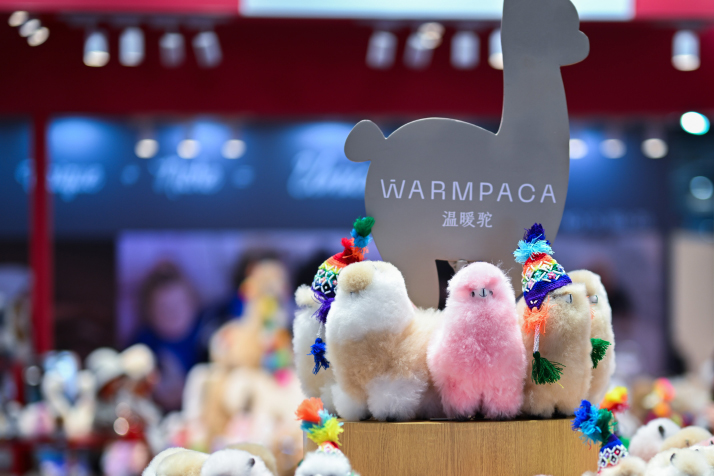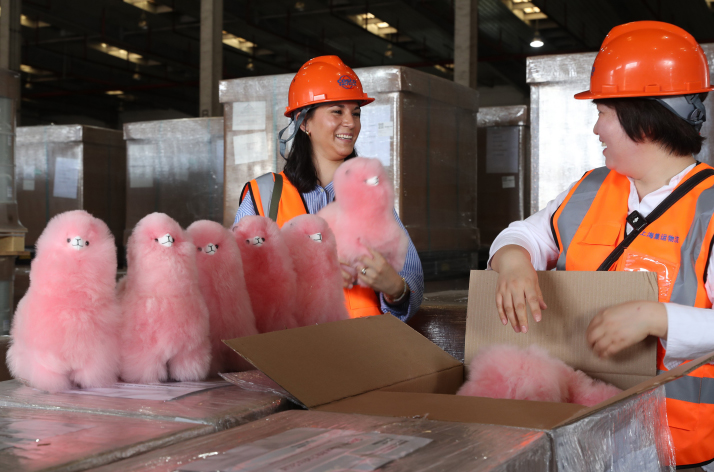| Business |
| An alpaca plush toy brand tells the interwoven stories of Peruvian artisans and Chinese consumers | |
|
|
 Alpaca wool plush toys on display at Warmpaca's booth at the Seventh CIIE in Shanghai on November 5
Nestled deep in the Andes Mountains and straddling the border between Peru and Bolivia sits Lake Titicaca, the highest navigable lake in the world. At the center of the lake is an island called Amantaní, where some 5,000 descendants of an ancient people, the Incas, have kept their ancestral traditions nearly untouched by the outside world. Roughly 17,000 km away in China, swarms of shoppers and tourists flow in and out of Raffles City, a high-end shopping destination located in the very heart of Shanghai. Among the lavishly decorated display windows of big multinational brands in this bustling commercial complex is a toy store window filled with cuddly stuffed animals, which come in all shapes, colors and sizes. Few would draw a connection between these parallel realities. However, these two worlds have converged through a chance encounter, and since then have grown ever-more deeply intertwined. A long thread of hope In 2016, 30-year-old Ma Yuxia, who studied Spanish in college and worked at a Chinese company's South American branch, quit her job and decided to start her own business. She tried her luck in Peru first, as she sensed opportunities there. The alpaca occupies an important place in the heart and soul of Peru, where about 4 million alpacas, which account for 80 percent of the world's total, roam the desolate, wind-swept highlands of the country's south. Over recent decades, the alpaca's golden fleece has become a major source of income for some 82,000 Andean families, most of whom have been weaving alpaca wool for generations and still adhere to ancient techniques of the Incas. Despite the widespread and increasingly industrialized production of alpaca wool products, most were sold only to tourists in the region, with only a small portion exported to Australia and New Zealand. Ma saw the potential in connecting alpaca products with the Chinese market. However, Ma's journey in Peru wasn't all sunshine and rainbows. As a complete novice in the world of business, she found herself being cold-shouldered by every local company and factory she visited. It was amid this stream of disappointments that she ran into a small stall selling handmade alpaca wool crafts at a street market in the southern city of Arequipa. The shop was run by Oswaldo Mamani, a Peruvian artisan belonging to the ancient tribe on Isla Amantaní. Like many of his peers, Mamani became an apprentice in the trade of alpaca wool crafts when he was a teenager. When Ma first met Mamani, he and his family lived in a ramshackle shed made of mud, and the stall he owned was a makeshift stand provided for free by the government. "Earnings were highly unstable. During rainy seasons, it was not unusual to go days without a sale," Ma told Beijing Review. Among the items artisans like Mamani produce are stuffed toy alpacas made from alpaca wool. Things took an unexpected turn when Ma gave the toy alpaca she purchased at Mamani's stall to one of her potential clients, who immediately placed an order for 1,000 more. Handcrafting 1,000 alpaca toys, however, was a formidable challenge for Mamani, whose annual sales back then barely reached 100 pieces. It was at that time that Ma met Ysabel Zea, a local psychologist who is deeply interested in Peruvian crafts. Having travelled extensively across Peru, Zea is well-acquainted with the locals and began working with Ma as a partner who oversees artisan recruitment and training. With the help of some 20 members from his family and his village, Mamani delivered the order on time. That year, Mamani was finally able to rebuild their mud house into a brick structure and redecorate the interior with new pieces of furniture.  Ysabel Zea (left) and Ma Yuxia, co-founders of Warmpaca, inspect the first batch of shipments for the Seventh China International Import Expo (CIIE) in a warehouse in Shanghai on October 14
Rings of growth However, due to a lack of distribution channels, Mamani only received two orders from Ma over the next two years. A second plot twist came in 2018, the year in which the inaugural China International Import Expo (CIIE) was launched in Shanghai. As the world's first import-focused expo, the CIIE was established to connect international brands with Chinese buyers. Ma decided to try her luck with the alpaca products again. However, she was placed on the waiting list, as all spots had already been taken by the time she registered. Two months later, a 9-square-meter corner space opened up, and Mamani's alpaca toys made their Chinese debut at the event under the brand Warmpaca. "We did not have much confidence initially, as we were only a small, unknown brand," Ma said. "As it turned out, all of our exhibits sold out, and this unexpected feat consolidated our faith in the Chinese market." In 2019, Zea embarked on her first trip to China, taking a 30-plus hour flight from Peru to Shanghai to participate in the Second CIIE. The event, which hosted more than 3,000 companies from 150 countries, exposed her to a wide range of global brands and led to the discovery of a key vulnerable spot in Warmpaca products, which was the lack of standardization. "The biggest challenge that we faced was to ensure a cohesive level of quality for these handmade products," Zea told Beijing Review, noting that many of the local artisans were not fully aware of the importance of product standardization. After countless trials and adjustments, the brand came up with a set of standards for its production: The eyes must be symmetrical; every alpaca should have a smiley face; its four legs must stand steadily. Just as Mamani's alpacas were entering brick-and-mortar toy stores across Beijing, Shanghai and other major Chinese cities, the COVID-19 pandemic hit in 2020, causing many shops to temporarily shut down. However, contrary to Ma and Zea's expectations, sales surged instead of taking a plunge. The main factor that triggered this growth was the brand's entry into the country's thriving e-commerce scene. That year, Warmpaca opened its online stores on Taobao and JD.com, two of China's largest online shopping platforms, as well as several online accounts aimed at promoting the brand on social media. "Our business really took off during the pandemic, which compelled us to shift our attention from expanding our physical presence in China toward reaching a wider audience on digital platforms," Zea said. As of now, Warmpaca's sales have increased by 500 percent compared to when the brand was first launched, with an average of 3,000 to 5,000 handcrafted alpaca toys shipped each month from Peru to China. Starting off from a humble corner booth at the CIIE, the brand has made its way into more than 100 shopping malls and 20 airports in major Chinese cities. It has also opened three flagship stores, with two located in Shanghai, including the store in Raffles City, and one in Xiamen, Fujian Province. The brand is also planning to expand into smaller cities in the country's vast inland regions. This domestic network is closely linked to Peru through the Chancay Port, a new shipping terminal located about 80 km north of Lima, the country's capital. Zea was present at the inaugural ceremony of the port on November 14. "It used to take 60 days for our products to be shipped from Peru to Shanghai. Now, that time has been reduced to 23 days, which could save us 100,000 yuan ($14,000) a year in international shipping costs," she said. Over the course of just eight years, what was an individual family workshop has expanded to incorporate members of Mamani's family, villagers from his hometown and other households dispersed throughout the Peruvian Andes. The business now supports a broad community of local artisans, benefiting over 400 people across some 100 families. When Ma returned to Peru to visit Mamani this July, the brick house had been replaced by a three-story villa with a clean white-and-blue exterior, beautifully tiled floors and two brand new vehicles parked in its garage. "We hope that, by joining our team, more and more Peruvian artisans can live their dreams, which can be as simple as building a new house or buying a dream car," Ma said. BR (Print Edition Title: Weaving Two Worlds Together) Copyedited by G.P. Wilson Comments to pengjiawei@cicgamericas.com |
|
||||||||||||||||||||||||||||||
|